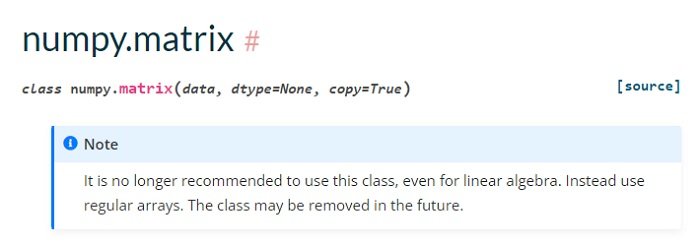
 Data Structure
Data Structure Networking
Networking RDBMS
RDBMS Operating System
Operating System Java
Java MS Excel
MS Excel iOS
iOS HTML
HTML CSS
CSS Android
Android Python
Python C Programming
C Programming C++
C++ C#
C# MongoDB
MongoDB MySQL
MySQL Javascript
Javascript PHP
PHP
- Selected Reading
- UPSC IAS Exams Notes
- Developer's Best Practices
- Questions and Answers
- Effective Resume Writing
- HR Interview Questions
- Computer Glossary
- Who is Who
Difference Between Matrices and Arrays in Python?
The arrays in Python are ndarray objects. The matrix objects are strictly 2-dimensional whereas the ndarray objects can be multi-dimensional. To create arrays in Python, use the Numpy library.
Matrices in Python
Matrix is a special case of two-dimensional array where each data element is of strictly same size. Matrices are a key data structure for many mathematical and scientific calculations. Every matrix is also a two-dimensional array but not vice versa. Matrix objects are a subclass of ndarray, so they inherit all the attributes and methods of ndarrays.
Example
Create a Matrix and Display
from numpy import * # Create a Matrix mat = array([['A',12,16],['B',11,13], ['C',20,19],['D',22,21], ['E',18,22],['F',12,18]]) # Display the Matrix print("Matrix = \n",mat)
Output
Matrix = [['A' '12' '16'] ['B' '11' '13'] ['C' '20' '19'] ['D' '22' '21'] ['E' '18' '22'] ['F' '12' '18']]
Example
Create a Matrix with mat()
The mat() function interprets an input as matrix -
import numpy as np # Create a Matrix mat = np.mat([[5,10],[15,20]]) # Display the Matrix print("Matrix = \n",mat)
Output
Matrix = [[ 5 10] [15 20]]
Arrays in Python
Array is a container which can hold a fix number of items and these items should be of the same type. To work with arrays in Python, import the NumPy library.
Example
import numpy as np # Create an array arr = np.array([5, 10, 15, 20]) # Display the Array print("Array =\n") for x in arr: print(x)
Output
Array = 5 10 15 20
Matrix Operations with Numpy Arrays
As per the official documentation, the class numpy.matrix will be removed in the future. Therefore, now the matrix algebra operations has to be done with Numpy Arrays.

Example
Let us now see some matrix operators with Numpy Arrays. First, we will create a matrix using arrays -
import numpy as np # Create Matrices mat1 = np.array([[5,10],[3,9]]) mat2 = np.array([[15,20],[10,11]]) # Display the Matrices print("Matrix1 = \n",mat1) print("Matrix2 = \n",mat2)
Output
Matrix1 = [[ 5 10] [ 3 9]] Matrix2 = [[15 20] [10 11]]
Example
Let us multiply the above matrices -
import numpy as np # Create Matrices mat1 = np.array([[5,10],[3,9]]) mat2 = np.array([[15,20],[10,11]]) # Display the Matrices print("Matrix1 = \n",mat1) print("Matrix2 = \n",mat2) mulMat = mat1@mat2 print("\nMatrix Multiplication = \n",mulMat)
Output
Matrix1 = [[ 5 10] [ 3 9]] Matrix2 = [[15 20] [10 11]] Matrix Multiplication = [[175 210] [135 159]]
Example
Get the Transpose -
import numpy as np # Create Matrices mat1 = np.array([[5,10],[3,9]]) mat2 = np.array([[15,20],[10,11]]) # Display the Matrices print("Matrix1 = \n",mat1) print("Matrix2 = \n",mat2) mulMat = mat1@mat2 print("\nTranspose = \n",mulMat.T)
Output
Matrix1 = [[ 5 10] [ 3 9]] Matrix2 = [[15 20] [10 11]] Transpose = [[175 135] [210 159]]

